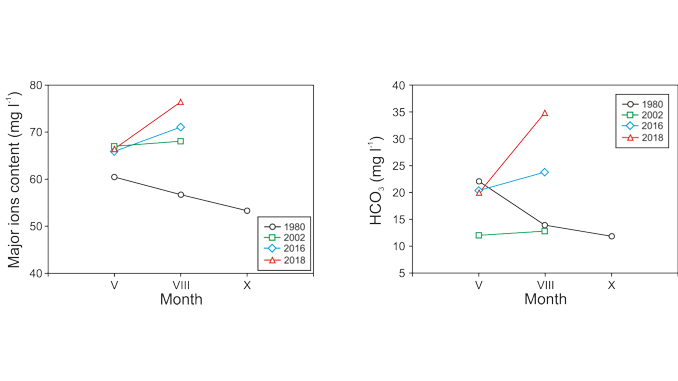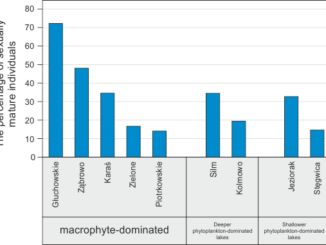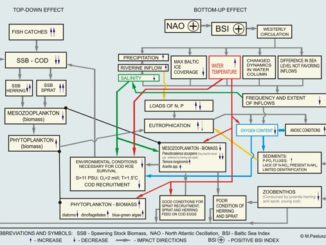
Paper category: Original research paper
Corresponding author: Alexander Rusanov (a_rusanov@yahoo.com)
DOI: 10.1515/ohs-2020-0016
Received: 05/11/2019
Accepted: 14/01/2020
Full text: here
Citation (APA style): Oceanological and Hydrobiological Studies, Volume 49, Issue 2, Pages 168–183, eISSN 1897-3191, ISSN 1730-413X, DOI: https://doi.org/10.1515/ohs-2020-0016.
Abstract
Long-term changes in hydrochemistry and community structure of phytoplankton and macrophytes were analyzed in the Sestroretskiy Razliv reservoir (northwestern Russia). The average content of total phosphorus (TP) in May–October increased from 73 µg Р l−1 in 1980 to 163 µg Р l−1 in 2000. A significant increase in average chlorophyll a content from 16.6 µg l−1 in 1980 to 84.7 µg l−1 in 2000 and a shift in phytoplankton composition to the dominance of cyanobacteria over diatoms indicated a change in the trophic status of the reservoir from meso-eutrophic to hypertrophic. In 2016 and 2018, average TP was 96 and 101 µg Р l−1, respectively. The average content of chlorophyll a was 43.6 µg l−1 in 2016 and 66.6 µg l−1 in warmer 2018, indicating persistent eutrophic conditions. Diatoms dominated both in 2016 and 2018, especially in 2016 characterized by unfavorable weather conditions. Cyanobacteria were more abundant in 2018 with higher summer temperatures. The decline of the total area covered by aquatic vegetation from 157 ha in 1980 to 76 ha in 2016 likely resulted from an increase in phytoplankton biomass and water turbidity. Based on the results of our observations, in addition to further reduction in nutrient loading, biomanipulation by introducing predatory fish as a restoration measure was proposed to improve the ecological status of the reservoir.
References
Ahlgren, G. (1978). Response of phytoplankton and primary production to reduced nutrient loading in Lake Norrwiken. Verh. Internat. Verein Limnol. 20: 840–845.
Arthaud, F., Mousset, M., Vallod, D., Robin, J., Wezel, A. et al. (2012). Effect of light stress from phytoplankton on the relationship between aquatic vegetation and the propagule bank in shallow lakes. Freshwater Biol. 57: 666–675. DOI:10.1111/j.1365-2427.2011.02730.x.
Belyakov, V.P., Drabkova, V.G., Makartseva, E.S., Prytkova, M.Ya., Sergeeva, L.V. et al. (2002). Current state of Sestroretskiy Razliv. In S.А. Kondratyev & G.T. Frumin (Eds.), Water objects of Saint-Petersburg (pp. 247–266). St.-Petersburg: Simvol (In Russian).
Benndorf, J. (1995). Possibilities and limits for controlling eutrophication by biomanipulation. Int. Rev. Ges. Hydrobiol. Hydrogr. 80: 519–534.
Chernova, E.N., Russkikh, Y.V., Voyakina, E.Ju. & Zhakovskaya, Z.A. (2014). Study of natural ecotoxicants – metabolites of blue-green algae in water bodies of different type in the Northwest Russia. Regional Ecology 35(1–2): 88–95 (In Russian with English summary).
Chorus, I. & Wesseler, E. (1988). Response of the phytoplankton community to therapy measures in a highly eutrophic urban lake (Schlachtensee, Berlin). Verh. Internat. Verein Limnol. 23: 719–728.
Chow-Fraser, P. (2005). Ecosystem response to changes in water level of Lake Ontario marshes: lessons from the restoration of Cootes Paradise Marsh. Hydrobiologia 539: 189–204. DOI: 10.1007/s10750-004-4868-1.
Edmondson, W.T. & Lehman, J.T. (1981). The effect of changes in the nutrient income on the condition of Lake Wachington. Limnol. Oceanogr. 26: 1–29. DOI: 10.4319/lo.1981.26.1.0001.
Egertson, C.J., Kopaska, J.A. & Downing, J.A. (2004). A century of change in macrophyte abundance and composition in response to agricultural eutrophication. Hydrobiologia 524: 145–156. DOI: 10.1023/B:HYDR.0000036129.40386.ce.
Gulati, R.D. (1990). Structural and grazing responses of zooplankton community to biomanipulation of some Dutch water bodies. Hydrobiologia 200/201: 99–118. DOI: 10.1007/BF02530332.
Gulati, R.D., Pires, L.M.D. & Van Donk, E. (2008). Lake restoration studies: Failures, bottlenecks and prospects of new ecotechnological measures. Limnologica 38: 233–247. DOI: 10.1016/j.limno.2008.05.008.
Guseva, К.А. (1959). Method of phytoplankton counting. Transactions of Institute of Reservoir Biology 2: 44–51 (In Russian).
Hudon, C., Gagnon, P., Amyot, J.-P., Létourneau, G., Jean, M., Plante, C. et al. (2005). Historical changes in herbaceous wetland distribution induced by hydrological conditions in Lake Saint-Pierre (St. Lawrence River, Quebec, Canada). Hydrobiologia 539: 205–224. DOI: 10.1007/s10750-004-4872-5.
Hutchinson, G.E. (1967). A treatise on limnology. II. Introduction to lake biology and the limnoplankton. New York: John Wiley & Sons, 1115 pp.
Jeffrey, S.W. & Humphrey, G.F. (1975). New spectrophotometric equations for determining chlorophylls a, b, c in higher plants, algae and natural phytoplankton. Biochem. Physiol. Pflanz. 167: 191–194. DOI: 10.1016/S0015-3796(17)30778-3.
Jeppesen, E., Søndergaard, M. & Jensen, J.P. (2003). Climate warming and regime shifts in lake food webs – some comments. Limnol. Oceanogr. 48: 1346–1349. DOI: 10.2307/3096661
Katanskaya, V.M. (1984). Higher aquatic vegetation. In Е.А. Stravinskaja (Ed.), Conservation of natural ecosystem of reservoir in urbanized landscape (pp. 66–82). Leningrad: Nauka (In Russian).
Katanskaya, V.M. (1988). Higher aquatic vegetation. In I.S. Trifonova (Ed.), Methodological aspects of limnological monitoring (pp. 102–113). Leningrad: Nauka (In Russian).
Kolada, A., Seppo, H., Kanninen, A., Søndergaard, M., Dudley, B. et al. (2009). Deliverable D3.2-1: Overview and comparison of macrophyte survey methods used in European countries and a proposal of harmonized common sampling protocol to be used for WISER uncertainty exercise including a relevant common species list. www.wiser.eu/download/D3.2-1.pdf, 31 pp.
Komárek, J. & Anagnostidis, K. (1999). Cyanoprokaryota. 1. Teil: Chroococcales. In Süsswasserflora von Mitteleuropa. Bd. 19/1. Jena: Gustav Fisher Verlag, 548 pp.
Komárek, J. & Anagnostidis, K. (2005). Cyanoprokaryota. 2. Teil: Oscillatoriales. In Süßwasserflora von Mitteleuropa. Bd. 19/2. Jena: Gustav Fisher Verlag, 900 pp.
Kondratyev, S.А., Ignatieva, N.V. & Karetnikov, S.G. (2016). External and internal loading of phosphorus to lake (on the example of reservoir Sestroretskiy Razliv). Regional Ecology 46(4): 7–18 (In Russian with English summary).
Krammer, K. & Lange-Bertalot, H. (1991). Bacillariophyceae. 2/3. Teil: Centrales, Fragilariaceae, Eunotiacea. In H. Ettl, J. Gerloff, H. Heynig & D. Mollenhauer (Eds.), Süsswasserflora von Mitteleuropa. 2nd ed. Heidelberg: Spektrum Akademischer Verlag, 599 pp.
Murphy, J. & Riley, J.P. (1962). A modified single solution method for the determination of phosphate in natural water. Anal. Chim. Acta 27: 31–36.
Nurminen, L. (2003). Macrophyte species composition reflecting water quality changes in adjacent water bodies of lake Hiidenvesi, SW Finland. Ann. Bot. Fennici 40: 199–208.
OECD (1982). Eutrophication of waters. Monitoring, assessment and control. Final report, Paris, 154 pp.
Papastergiadou, E., Kagalou, I., Stefanidis, K., Retalis, A. & Leonardos, I. (2010). Effects of anthropogenic influences on the trophic state, land uses and aquatic vegetation in a shallow Mediterranean lake: Implications for restoration. Water Resour. Manag. 24: 415–435. DOI: 10.1007/s11269-009-9453-y.
Pawlik-Skowrońska, B., Pirszel, J. & Kornijów, R. (2008). Spatial and temporal variation in microcystin concentrations during perennial bloom of Planktothrix agardhii in a hypertrophic lake. Ann. Limnol. – Int. J. Lim. 44(2): 145–150. DOI: 10.1051/limn:2008015.
Pedchenko, A.P., Shurukhin, A.S., Bogdanov, D.V., Kuznetsov, A.F., Sukhin, A.I. et al. (2017). Current state of fish community in Sestroretskiy Razliv. Environment of Saint-Petersburg 2(4): 50–61 (In Russian).
Ptacnik, R., Lepistö, L., Willén, E., Brettum, P., Andersen, T. et al. (2008). Quantitative responses of lake phytoplankton to eutrophication in Northern Europe. Aquatic Ecology 42(2): 227–236. DOI: 10.1007/s10452-008-9181-z .
Rusanov, A.G. (2008). Long-term changes in aquatic vegetation in lake Krasnoe. In I.S. Trifonova (Ed.), Long-term changes of biological communities in a mesotrophic lake in conditions of climatic fluctuations and eutrophication (pp. 83–105). St.-Petersburg: Lema (In Russian).
Sand-Jensen, K. (1997). Eutrophication and plant communities in Lake Fure during 100 years. In K. Sand-Jensen & O. Pedersen (Eds.), Freshwater biology. Priorities and development in Danish research (pp. 26–38). Copenhagen: Gad.
Sand-Jensen, K., Riis, T., Vestergaard, O. & Larsen, S.E. (2000). Macrophyte decline in Danish lakes and streams over the past 100 years. J. Ecol. 88: 1030–1040. DOI: 10.1046/j.1365-2745.2000.00519.x.
Scheffer, M., Hosper, S.H., Meijer, M.L., Moss, B. & Jeppesen, E. (1993). Alternative equilibria in shallow lakes. Trends Ecol. Evol. 8: 275–279. DOI: 10.1016/0169-5347(93)90254-M.
Scheffer, M., Straile, D., Van Nes, E.H. & Hosper, H. (2001). Climatic warming causes regime shifts in lake food webs. Limnol. Oceanogr. 46: 1780–1783. DOI: 10.4319/lo.2001.46.7.1780.
Scheffer, M. & Van Nes, E.H. (2007). Shallow lakes theory revisited: various alternative regimes driven by climate, nutrients, depth and lake size. Hydrobiologia 584: 455–466. DOI: 10.1007/s10750-007-0616-7.
Semenov, A.D. (1977). Guidebook on chemical analysis of inland surface waters. Leningrad: Hydrometeoizdat, 542 pp. (In Russian).
Sergeeva, L.V., Spasskaya, I.S., Khomutova, V.I. & Yakovleva, L.V. (1984). Characteristics of bottom deposits of Sestroretskiy Razliv and history of its formation. In Е.А. Stravinskaja (Ed.), Conservation of natural ecosystem of reservoir in urbanized landscape (pp. 92–107). Leningrad: Nauka (In Russian).
Skov, C. & Nilsson, P.A. (2007). Evaluating stocking of YOY pike Esox lucius as a tool in the restoration of shallow lakes. Freshwater Biol. 52: 1834–1845. DOI: 10.1111/j.1365-2427.2007.01795.x.
Sokal, R.R. & Rohlf, F.J. (1995). Biometry: The principles and practice of statistics in biological research. 3rd edition. New York: W.H. Freeman and Co., 887 pp.
Søndergaard, M., Jeppesen, E., Laursden, T.R., Skov, C., Van Nes, E.H. et al. (2007). Lake Restoration: successes, failures, and long-term effects. J. Appl. Ecol. 44: 1095–1105. DOI: 10.1111/j.1365-2664.2007.01363.x.
Stewart, C.C. & Freedman, B. (1989). Comparison of the macrophyte communities of a clearwater and a brown-water oligotrophic lake in Kejimkujik National Park, Nova Scotia. Water, Air, Soil Pollut. 46: 335–341.
Stravinskaja, Е.А., Judin, E.A. & Veselova, M.F. (1984a). Physical characteristics of catchment area and history of Sestroretskiy Razliv. In Е.А. Stravinskaja (Ed.), Conservation of natural ecosystem of reservoir in urbanized landscape (pp. 6–20). Leningrad: Nauka (In Russian).
Stravinskaja, Е.А., Kulisheva, Ju.I, Judin, E.A., Trifonova, I.S., Senatskaya, N.Ju. et al. (1984b). Eutrophication of Sestroretskiy Razliv and its determining factors. In Е.А. Stravinskaja (Ed.), Conservation of natural ecosystem of reservoir in urbanized landscape (pp. 21–82). Leningrad: Nauka (In Russian).
Toivonen, H. & Huttunen, P. (1995). Aquatic macrophytes and ecological gradients in 57 small lakes in southern Finland. Aquat. Bot. 51: 197–221. DOI: 10.1016/0304-3770(95)00458-C.
Trifonova, I.S. (1990). Ecology and succession of lake phytoplankton. Leningrad: Nauka, 174 pp. (In Russian).
Trifonova, I.S. & Pavlova, O.A. (2005). Structure and succession of phytoplankton in urbanized water bodies of St.-Petersburg. Hydrobiol. J. 41(1): 3–12. DOI: 10.1615/HydrobJ.v41.i3.10.
Trifonova, I.S. & Senatskaya, N.Ju. (1984). Phytoplankton and primary production. In Е.А. Stravinskaja (Ed.), Conservation of natural ecosystem of reservoir in urbanized landscape (pp. 43–58). Leningrad: Nauka (in Russian).
UNESCO (1966). Determinations of photosynthetic pigments in seawater. Rep. SCOR/UNESCO WG 17, UNESCO Monogr. Oceanogr. Methodol., 1, Paris, 69 pp.
Veselova, M.F. & Judin, E.A. (1984). Hydrology, water balance and suspended solids. In Е.А. Stravinskaja (Ed.), Conservation of natural ecosystem of reservoir in urbanized landscape (pp. 11–20). Leningrad: Nauka (In Russian).
Wetzel, R.G. (2001). Limnology: Lake and river ecosystems. 3rd edition, San Diego: Academic Press, 1006 pp.




Bądź pierwszy, który skomentuje ten wpis